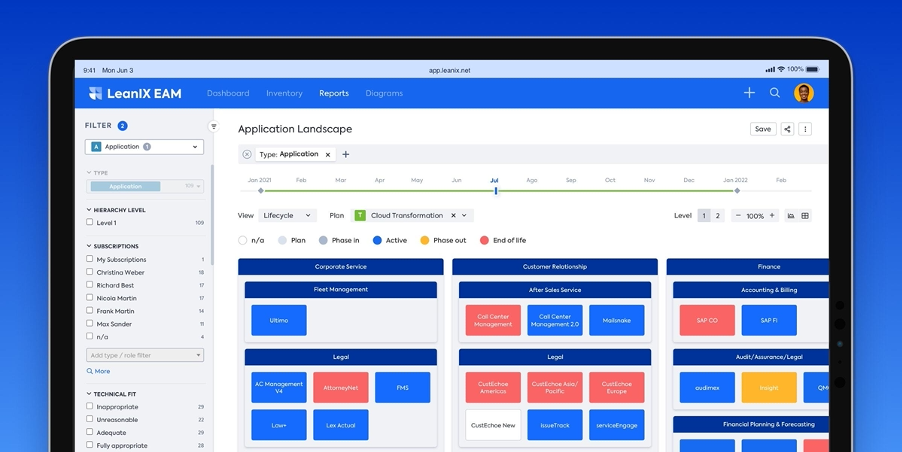
Application rationalization is vital for success in business transformation. Discover why you need to rationalize your portfolio before any attempt at transformation.
Application rationalization is vital for organizations to maintain agility and optimize costs. This is particularly important before attempting a business transformation, such as cloud migration or changing your enterprise resource planning (ERP) system.
Before you attempt any kind of digital transformation, you need to ensure your current landscape is optimized, or else you risk not only migrating any issues with your architecture to the new state, but also creating new problems. Application rationalization ensures you're transforming the best version of your current architecture, and are fully prepared for your transformation process.
Still, this isn't just a one-off process. Application rationalization needs to be a regular habit to support the need for continuous transformation that modern industry calls for.
To support regular rationalization and continuous transformation, you need a system that can constantly track your application portfolio and support you in designing roadmaps for transformation. That's where LeanIX EAM comes in:
LEANIX USE CASE: Application Rationalization
In the meantime, let's consider what app rationalization is, why it's vital before a business transformation, and what can go wrong if you attempt to transform without rationalization.
What Is Application Rationalization?
Application rationalization is the process of organizing and streamlining your software application portfolio to best support your business goals. Best practice is to categorize each application according to the Gartner TIME methodology:
Tolerate - accept the application in its current state for the time being
Invest - prioritize gaining maximum value from a priority application
Migrate - work on finding a better application to fulfill this need
Eliminate - remove the application as it is not needed or desirable
Once you've performed this categorization, you can:
- remove applications that are no longer needed
- begin work to sunset applications that are needed, but unwanted
- replace applications with ones that are a better fit or migrate them to the cloud
- take the budget you have saved with the above actions and invest in your key applications
It's vital to carry out application rationalization to ensure your application portfolio is optimized and delivering the best-possible return on investment (ROI). Just as important is the need to repeat this process on a regular basis to ensure your portfolio is adapting to the changing needs of your business.
Concerningly, however, only 15% of organizations carry out application rationalization on a regular basis, according to our 2023 IT Cost Optimization Survey. To find out more, download the full survey below:
Those organizations that carry out application rationalization on a regular basis will be prepared for whatever challenges they face. It's particularly important to bring your portfolio in-line before any kind of business transformation.
Why Rationalization Matters For Transformation
Application rationalization is essential for business transformation. Whether you're performing a merger, updating your enterprise resource planning (ERP) system, migrating to the cloud, or simply growing, optimizing your IT estate first is key.
If you don't rationalize before your transformation, then you'll be wasting time and resources on transforming, migrating, or adapting legacy applications that you could leave behind. Conversely, a rationalization will highlight key applications that should be prioritized and protected from downtime.
In addition, without rationalization, any inefficiencies or problems with your current IT landscape will simply be duplicated into your new state after your business transformation. What's worse, the stress of transferring struggling programs to a new host or setup may bring to light new problems you hadn't noticed before.
Imagine you were moving house and needed to pack up all your belongings for transport. You would go through the items to see what could be thrown away first, then box them up safely before moving them.
In the same way, an application rationalization can make sure you're fully prepared for your transformation before you start. If you don't, your transformation could fail.
Transformation Without Rationalization
An infamous BCG study found that 70% of digital transformations fail. Application rationalization is key for giving you the best chance of success.
We've already considered the issues of duplicating inefficiencies to the new state, and the wasted effort migrating legacy applications. Now, let's consider five other possible outcomes if you proceed with an attempted business transformation without getting your application portfolio in order first:
1 Apps That Don't Work At High Altitude
Your legacy applications aren't designed to be as flexible as modern software, and may perform below acceptable levels, or not at all, once you've completed your business transformation. An application rationalization exercise will ensure you've stress-tested your applications and determined whether they will operate as needed within your new IT landscape.
2 Forgetting Anything?
Now business-led IT has become the norm and the use of software-as-a-service (SaaS) applications is commonplace, it's inevitable that there will be applications in use within your organization that aren't documented in your application portfolio. Application rationalization will involve finding these 'shadow IT' applications and making sure they're taken into account for your transformation.
3 Unexpected Costs
From upgrading applications that aren't fit for purpose after your transformation, to unexpected migration costs from undiscovered applications, you won't have a full estimation of the costs of your business transformation until you've completed an application portfolio assessment.
4 Employee Reluctance
A major factor in the success of your business transformation will be stakeholder buy-in. An application rationalization effort will involve gathering evidence to support your decisions, and identifying the business owner of each application.
5 Regulatory Woes
Finally, it's concerningly plausible that you might complete a data migration only to find that your new architecture is no longer compliant with regulatory requirements. This only becomes more complex when you consider the differences in regulation across different regions of the world.
Application Rationalization Never Ends
To optimize your chances of success in your business transformation, you need to complete an application rationalization effort. Yet, too often, the research and data you discover during the process is immediately misplaced when you're finished.
Preserving that information in a dedicated database will allow you to repeat app rationalization efforts on a regular basis, without having to start from scratch every time. This means you'll be ready to undergo a business transformation at any time, no matter what the market demands.
The speed of modern business requires going beyond a simple one-off transformation, and instead adopting a culture of continuous transformation. To meet this challenge, you need the agility that comes from regular application rationalization.
How LeanIX EAM Helps

Regular application rationalization for continuous transformation requires a system that can store and organize your application portfolio data, so it's constantly at hand to support your business transformations. LeanIX EAM is designed specifically to support your enterprise architects in tracking the shape of your IT landscape.
To find out more about how LeanIX EAM can support your business transformation, book a demo:





